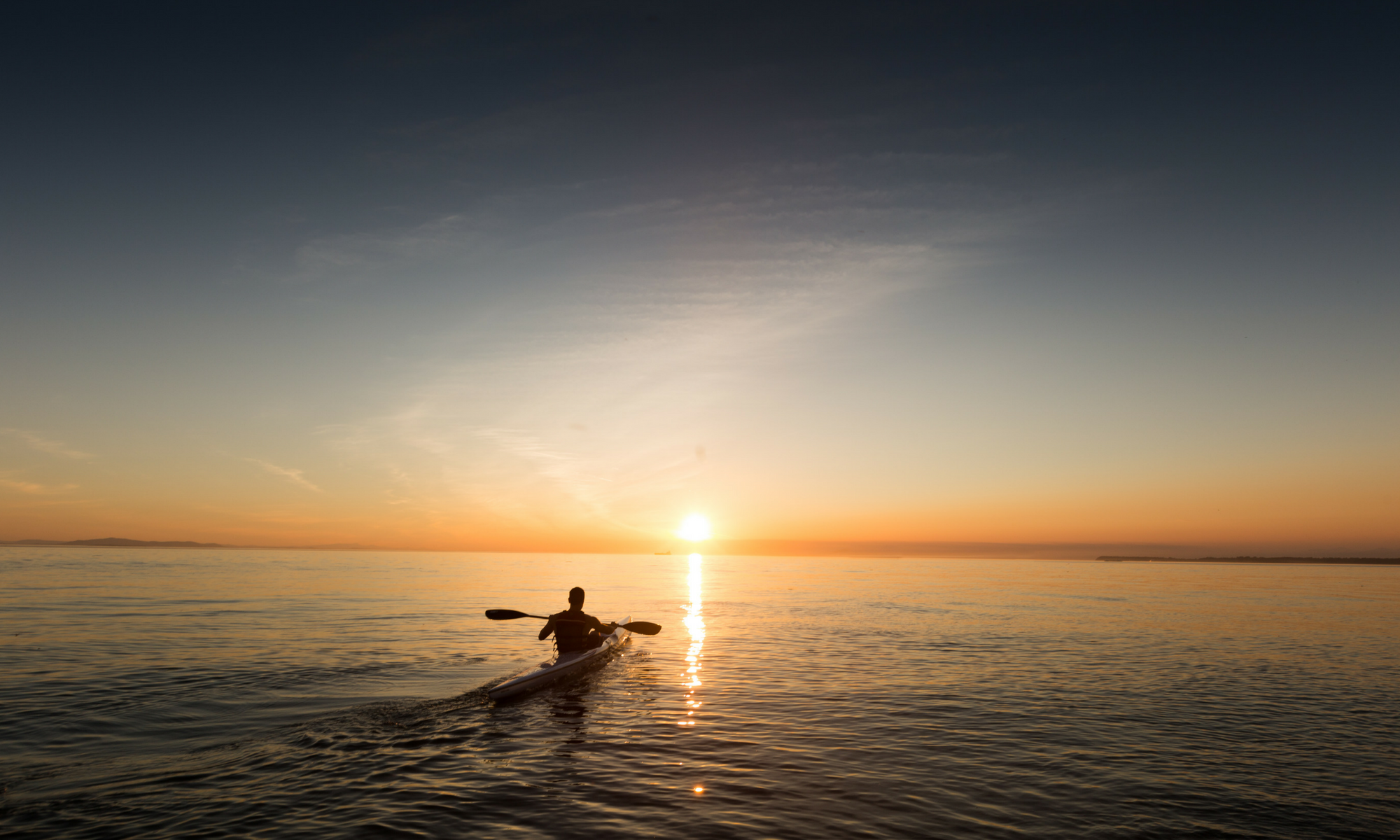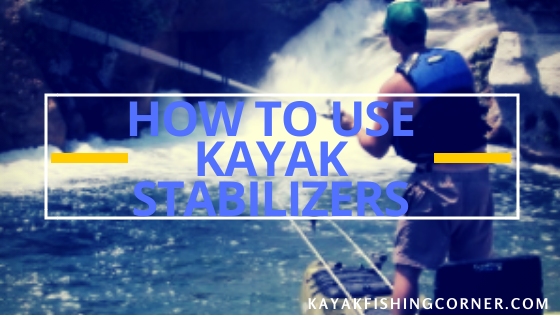Jump Ahead To:
HOW TO USE KAYAK STABILIZERS: INTRO
KFC always suggests that its readers visit our Kayak Stabilizer Ultimate Guide for the best education on all things related to kayak stabilizers. The Ultimate Guide is great resource to help you build your kayak stabilizer knowledge before learning all of the different ways how to use kayak stabilizers when kayak fishing. You can also check out our rank of The 5 Best Kayak Outriggers!
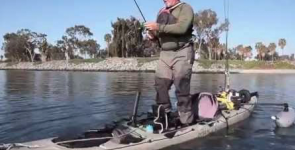
Basics
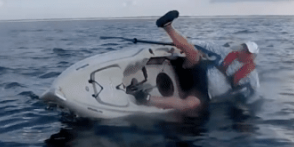
First, as an Amazon Associate, I earn from qualifying purchases.
We’ve written this post to include all of the important details to help you learn how to use kayak stabilizers when you are kayak fishing. We’ve organized this post into a number of separate categories. We begin with a short “how to” checklist to make sure that you learn how to use kayak stabilizers with the proper technique. Next, we list several of the features that we always suggest our readers look for in kayak stabilizers when deciding which model to buy. After that, we’ve included a link to one of the best kayak stabilizers available for purchase today – its our favorite! Lastly, we have posted a brief write up of our own experience when learning how to use a kayak stabilizer.
Did you know that even the most experienced kayak fishermen will sometimes be unfamiliar with how to appropriately use a kayak stabilizer or kayak “outrigger” (as they are sometimes called)? It is for that very reason that we decided to write this post! If you take a look at the image above, you’ll notice one thing. He’s overturning his kayak! This kayak fisherman would benefit from a foundational knowledge of how to use kayak stabilizers, and after you read this post, we suspect that you’d be able to teach him a thing or two!
Our favorite bonus of learning how to use kayak stabilizers is that it allows you to sit, stand, and then sit again. You don’t even have to make any adjustments to your fishing kayak! Altering your position while kayak fishing directly results in higher levels of success while on the water! Ok, but why does this occur?Well, sitting and standing allows you to stretch out. When you are able to stretch out, you’ll become less tired after long periods of time spent sitting still. It would then make sense that the less tired you are, the longer you’ll be able to stay on the water! Then, you guessed it, the longer you stay on the water, the more fish you are going to catch from your kayak!
How to Use Kayak Stabilizers
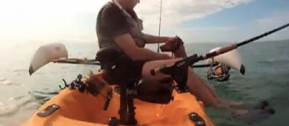
Please note: This post contains affiliate links. An affiliate link means that we may earn advertising/referral fees if you make a purchase through our links.
Shortcut to Kayak Stabilizer Review
Now its time to learn a few stabilizer basics. Starting with the basics is critical because you won’t have much use for a kayak stabilizer if you don’t know how to properly attach it or use it! This KFC checklist will serve as a short guide. Read it, and you’ll be ready to go quickly!
- Decide where you want to install your kayak stabilizer.
- The best location is located roughly 2/3rds and 3/4ths of the way towards the rear of the fishing kayak.
- Installing the stabilizer near the rear of the kayak places the stabilizer’s pontoons out of the way of your paddling motion.
- It also decreases the risk of entanglement of the fishing line and other kayak fishing accessories.
- One extra bonus is that it allows for more stability. Why? Well, most kayak fishermen stand close to the rear of the fishing kayak while they are casting their fishing lines.
- Now is the time to secure the kayak stabilizer to the hull of the fishing kayak.
- Do this by using the mounting hardware that came with your stabilizer. Do not try to improvise with your own hardware! If you’ve done the installation correctly, it should look something like the example below:
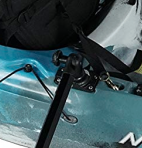
- After you’ve made a secure connection, you’ll need to attach your pontoons to the arms of the kayak stabilizer.
- The attachment of the pontoons should not be taken lightly, these are the components that keep you balanced against the water!
- Never let your pontoon become detached while you are on the water. If one, or even two, pontoons become detached, grab them as fast as you can, as they’ll float away!
- Adjust the angle of the kayak stabilizer arms to suit your desire (up, down, or parallel).
- Select your angle based upon the type of water you are encountering.
- Tilting the arms upwards ensures that they do not engage unless the kayak is leaning far one way or the other.
- Placing them almost parallel with the water (shown in the example below) helps you glide evenly along with the fishing kayak.

- Tilting them downward puts increased pressure on the water but can also slow you down!
- Never angle the stabilizer at too steep of an angle downward. The steeper the angle, the more strain on the connection point. This could cause the connection point to break free, which would damage the hull of the kayak!
Overview
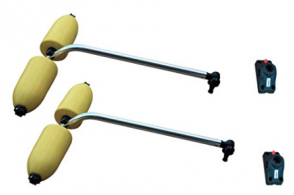
Learn how to use kayak stabilizers properly! Trust us, doing so will make you much safer on the water, regardless of whether you are traveling by paddle or by kayak trolling motor. A kayak stabilizer is also important for helping you remain static in one location. Why would you want to stay still while out on the water? Well, for times when you’ve finally made your way to your favorite fishing spot! Having the ability to stand and cast with greater balance while at your favorite location is a huge bonus!
Let’s talk about some basics laws of motion. Listen, KFC is much more interested in kayak fishing than we are in science, but it helps to spend a little bit of time learning! And, it makes us better kayak fishermen! Kayak stabilizers are built to increase your surface area. The increased surface area results in a counter balancing system. Think about it this way, if pressure is pushing against one side of your fishing kayak (a big wave, swift current, or even a strong wind), the kayak stabilizer will “push back”. This system of pushing is really just the transferring of pressure by sending it through to the other side of the fishing kayak! See, that wasn’t too bad.
First things first, you are not going to need your kayak stabilizer for every single kayak fishing trip. A lot of the time, the water may be calm enough that the kayak stabilizer never serves much purpose. But here is the cool part. The stabilizer also won’t disadvantage you. Water conditions are dynamic. Since the kayak stabilizer isn’t “harming” you or your kayak, why not keep it installed and available, just in case? Better off having the kayak stabilizer but not needing it, instead of the other way around!
Important Features, Quick Tips
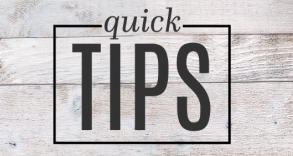
- Length – A stabilizer measuring somewhere between 30 to 36 inches is your best bet. Multiplying this length by two (because you will have two kayak stabilizers) then adding to the width of a standard fishing kayak, results in a surface area of well over 9 feet. This is roughly 300% bigger than the surface area of a fishing kayak without a stabilizer kit. Remember, the greater the surface area, the higher the amount of balance and control!
- Location – The kayak stabilizers should be placed near the read of your fishing kayak. Ours is located about 3/4ths of the way toward the rear, right behind our seat. This spot is best for keeping the kayak stabilizer out of the way of my paddling motion. It keeps the stabilizer from tangling with my fishing line.
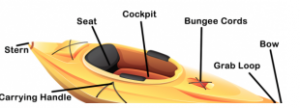
- Pontoon – The pontoons are essentially small floats (many times called ‘buoys’) that are located at the end of the kayak stabilizer’s arms. You’ll want very buoyant pontoons, as this will result in a greater ability of the stabilizer to add stability and control while navigating along the water. We think that pontoons that are constructed of molded PVC are the best performers. Especially for kayak fishing. Why? Mainly because of their durability, buoyancy, and safety. Most pontoons have the additional bonus of increasing your visibility while on the water, as they are usually colored bright yellow or orange!
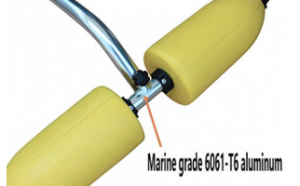
- Adjustability – Sometimes you’ll want to raise your kayak stabilizers out of the water, like when you need to move fast. Still other times you’ll want to adjust the angle of the kayak stabilizer, like when you need to make the surface area bigger to help push against winds and waves.
Adjustability requires that the kayak stabilizer come with a component that includes an internal ratcheting system. The internal ratcheting allows you to adjust the kayak stabilizer arms to a number of different angles. We’ve added a close up image of one such component below, though sometimes they vary in style and shape.
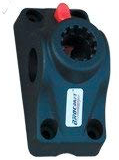
You might find that you need to alter the position and angle of the kayak stabilizer arms to deepen the rudder into the water. Once lowered, it is easier to keep the fishing kayak on a more direct and narrow course. Other times you might adjust the stabilizer arms to raise the amount of pressure you are putting on the water.
Doing so enlarges your surface area. The enlarged surface area creates the counter balancing desired. After all, this counter balancing is the top priority goal of any kayak stabilizer kit. Casting from the standing position immediately comes just that much easier! We can assure you that you’ll never experience this stability without properly learning how to use kayak stabilizers!
Our Favorite Model
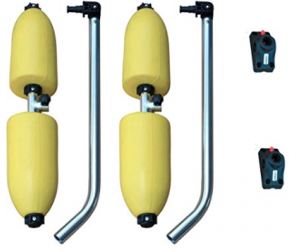
Even though there are many kayak stabilizers on the market today, merely a handful of them are worth purchasing, at least in our opinion. The model of stabilizer that we have showcased below is one that is certainly worthy of a recommendation!
(Commissions Earned)
Now that you have taken the time to read through the list of important features above, you’ll be pleased to learn that this particular stabilizer kit satisfies all of the criteria. The length of the stabilizer arms is perfect to provide you proper stability (even in the ocean)! Its adjustability allows you to make changes, even while you are out on the water. This is a great fit for those of our readers who are out on the water for many hours at a time. Also, the pontoons are very durable, highly buoyant, and come in a very noticeable color, immediately adding to your visibility at dusk, dawn, and times in between!
The link above will take you to the product page, which should be helpful if you have additional questions or want to see more about this stabilizer’s specifications.
Not interested in buying a traditional kayak stabilizer? Maybe a self balancing kayak pontoon hybrid would better suit your kayak fishing style.
If you end up buying the stabilizer, please be sure to write in to KayakFishingCorner.com and share your experience with the rest of this kayak fishing community! Looking for a great “all around” kayak stabilizer? Check out KFC’s post on the best all around kayak stabilizer for kayak fishing!
My Experience
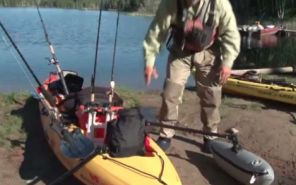
Prior to learning how to use kayak stabilizers, and actually even prior to owning a kayak stabilizer myself, I experienced a very tough change in weather conditions while kayak fishing on a nearby lake. I was not watching the water like I should have been.

The high winds came out of nowhere, and these waves when added with the wakes of all the motor boats scattering for shelter from the storm, was almost enough to flips over my fishing kayak!
I had many hundreds of dollars worth of kayak fishing gear and accessories on board with me, not to mention my kayak itself. I did NOT want to accidentally flip! When I finally reached the safety of the shore, I decided that it was time to buy a kayak stabilizer. The downside of not purchasing the stabilizer was simply too high. It wasn’t worth it to go kayak fishing, even when the forecast called for safe conditions, without the assurances provided by a reliable kayak stabilizer!
By the way, if your kayak fishing trips often lead you to the ocean or sea, you would be foolish to not consider a kayak outrigger for ocean based kayak fishing. The conditions on the sea change so rapidly, and the currents can alter direction without notice. A kayak stabilizer or outrigger specifically built to handle the ocean will help keep you safe! Oh, and if your interested in learning about the origins of kayak fishing and how the origins center around the sea, KFC has authored an in-depth history of kayak fishing for your reading pleasure!
HOW TO USE KAYAK STABILIZERS: SUMMARY
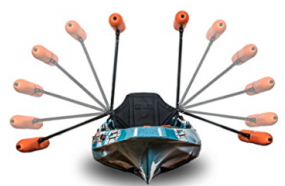
Remember, the kayak stabilizer will not be a “permanent” fixture upon your fishing kayak. Just snap the stabilizers on and off as your needs adjust. We love the flexibility of “on again” and “off again” type products, and this kayak stabilizer is a perfect example!
KFC hopes that this post has helped educate you about how to use kayak stabilizers. What a great piece of kayak fishing gear for beginners and professionals alike! If you have any detailed questions about how to use kayak stabilizers for kayak fishing, please make sure to share by commenting towards the end of this article. Our #1 favorite thing is to hear from the kayak fishing community!
If you are now inspired by your new knowledge regarding how to use kayak stabilizers, and you’ve decided to buy one for yourself, we are certain that you’ll be thrilled with any of the different kinds of stabilizers we’ve linked to above! The question is, which one will YOU pick!? Want a hint as to the best kayak stabilizer based upon KFC’s research? Use these 7 exercises to help you improve your balance!
Have you ever wanted to go kayak fishing in the mountains? Check out what Colorado has to offer, here!
Comments
Do you have any questions about how to use kayak stabilizers? What about kayak fishing in general? Want to share a helpful tip? Please share with the rest of the KayakFishingCorner community by posting in the Comments section below! We love to hear from you!
